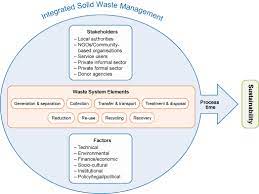A typical waste management system in a low- or middle-income country includes the following elements:
- Waste generation and storage
- Segregation, reuse, and recycling at the household level
- Primary waste collection and transport to a transfer station or community bin
- Street sweeping and cleansing of public places
- Management of the transfer station or community bin
- Secondary collection and transport to the waste disposal site
- Waste disposal in landfills
Collection, transport, and treatment of recyclables at all points on the solid waste pathway (collection, storage, transport, and disposal).
Waste Storage
Except in systems using the water carriage of refuse, the refuse from households cannot be collected as it is produced. Thus some means of intermediate storage is essential. For domestic refuse, such storage is provided by the dustbin.
Read Also : Other Waste Treatment Technologies
Establishments producing larger quantities of refuse, e.g. blocks of flats with refuse chutes, will use large containers which can be removed complete or which can be emptied into special collecting vehicles.

The size of the domestic dustbins is most important. It should be large enough to hold all the refuse produced between collections and at the same time, it should be small enough to be hoisted (carried) by one person, possibly with but preferably without the assistance of another in lifting the bin to the shoulder.
Qualities of a Standard Dustbin
The figures below shows various types of waste bins used in modern- day waste storage. In addition to the size considerations noted above, a standard waste bin should have the following qualities or characteristics:
Have a tight fitting cover and should be made of materials resistant to waster
Made of galvanized metal or plastic to resist rusting
Be fitted with two side handles for easy hoisting or lifting
Be easily filled, emptied and cleansed
Be placed always on a concrete slab.

